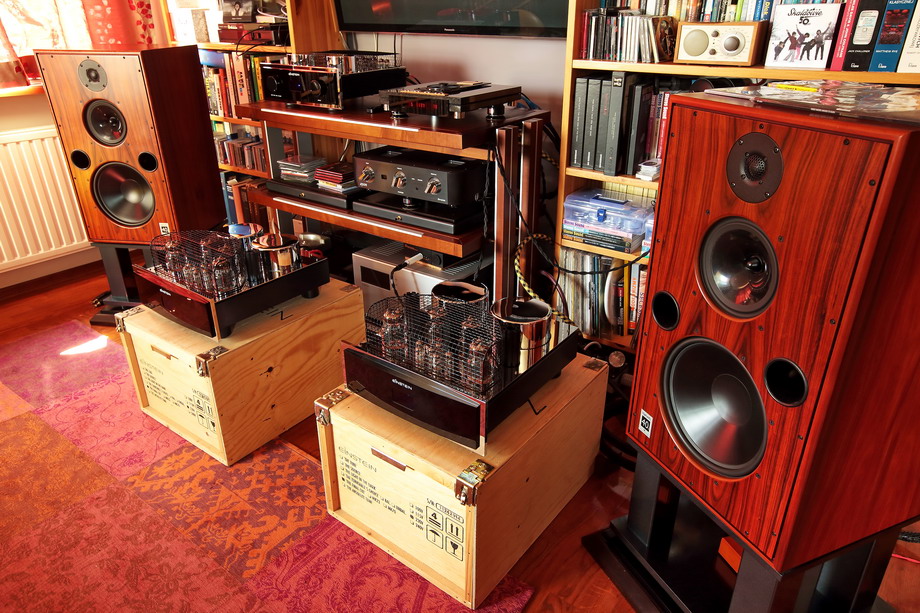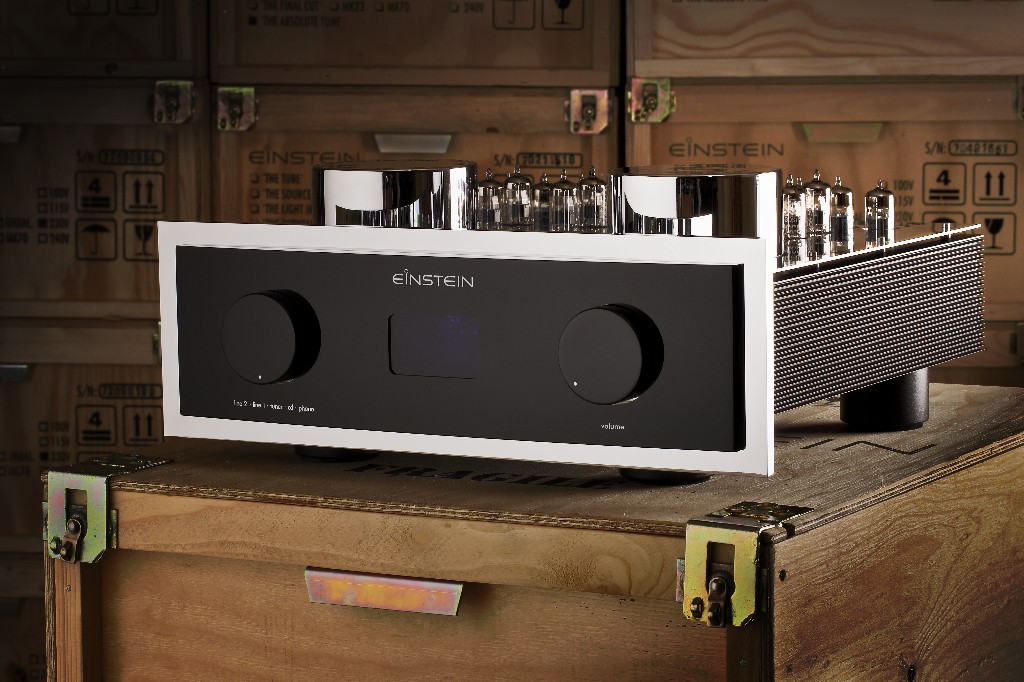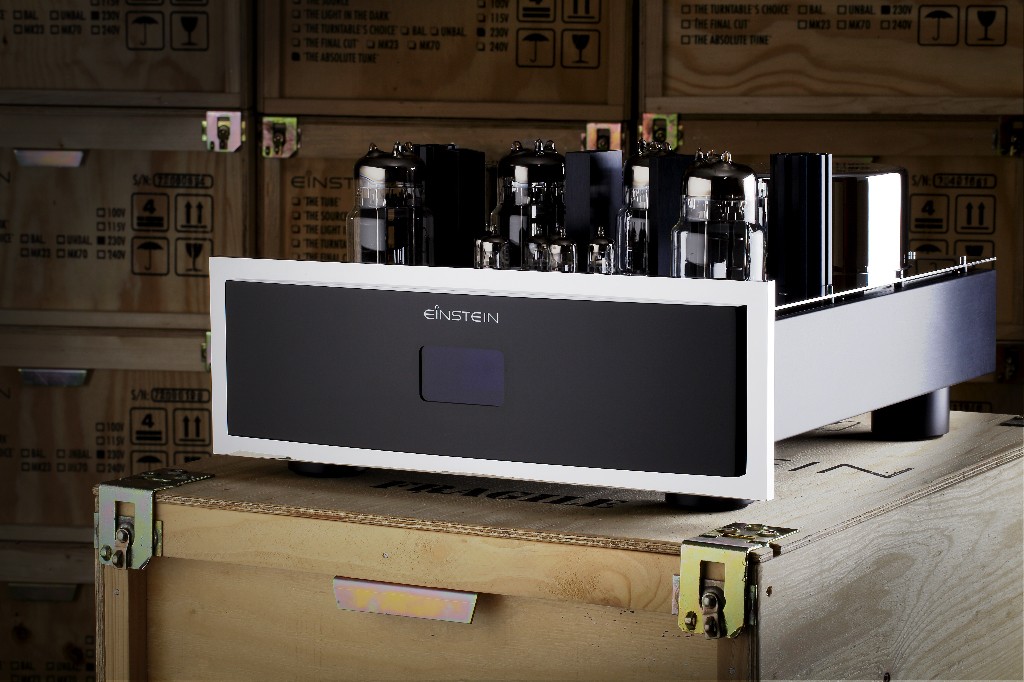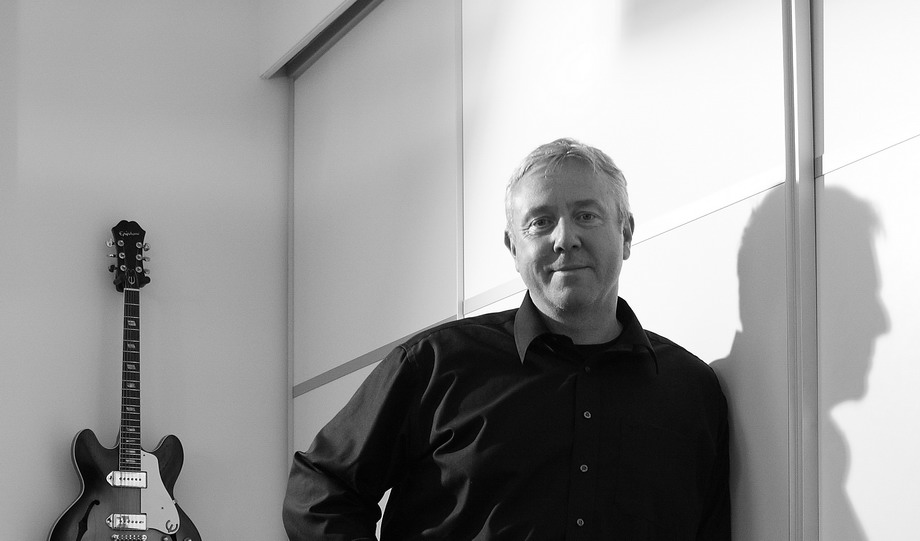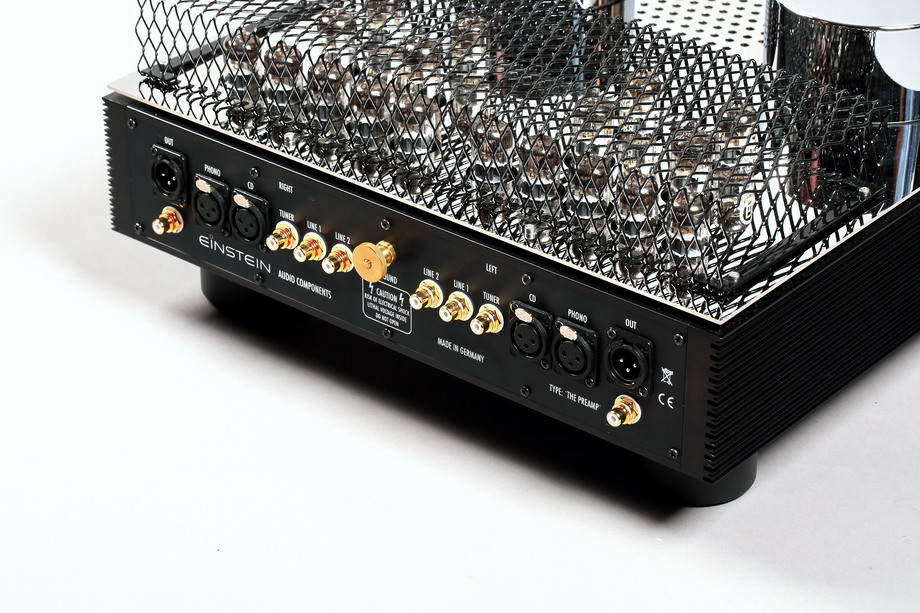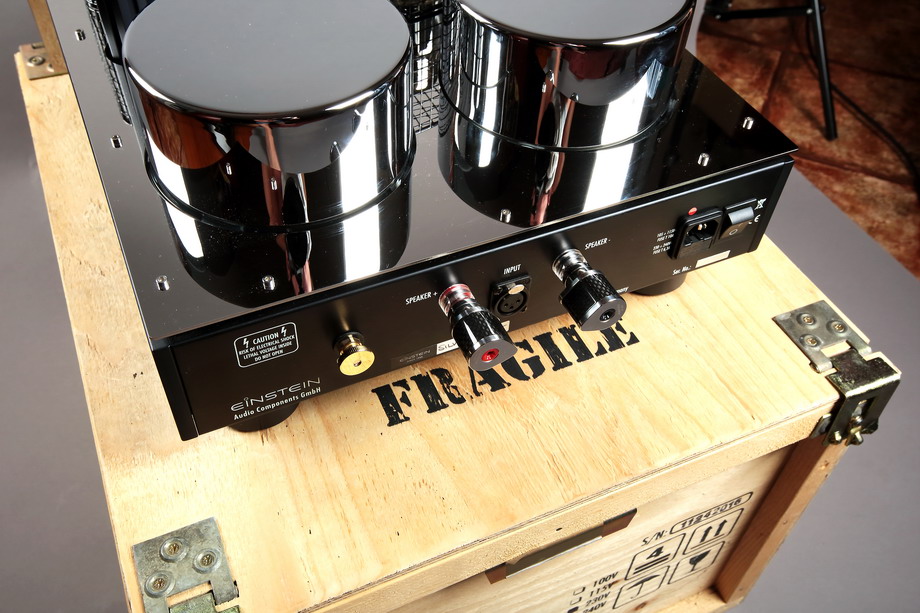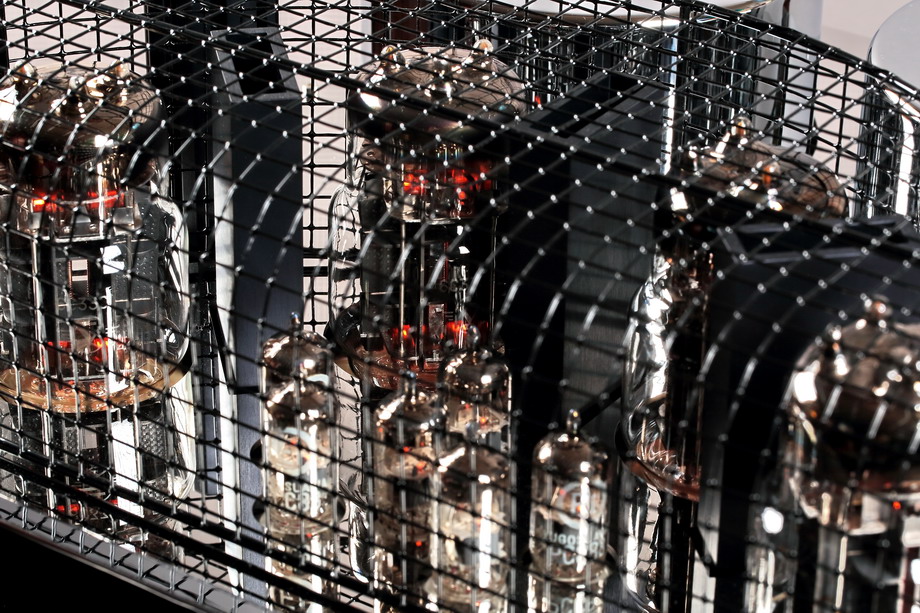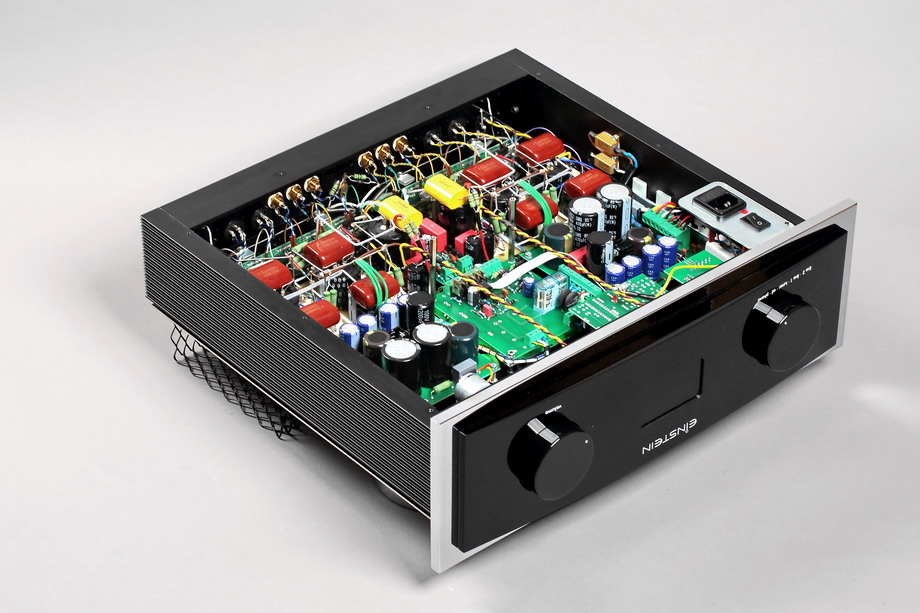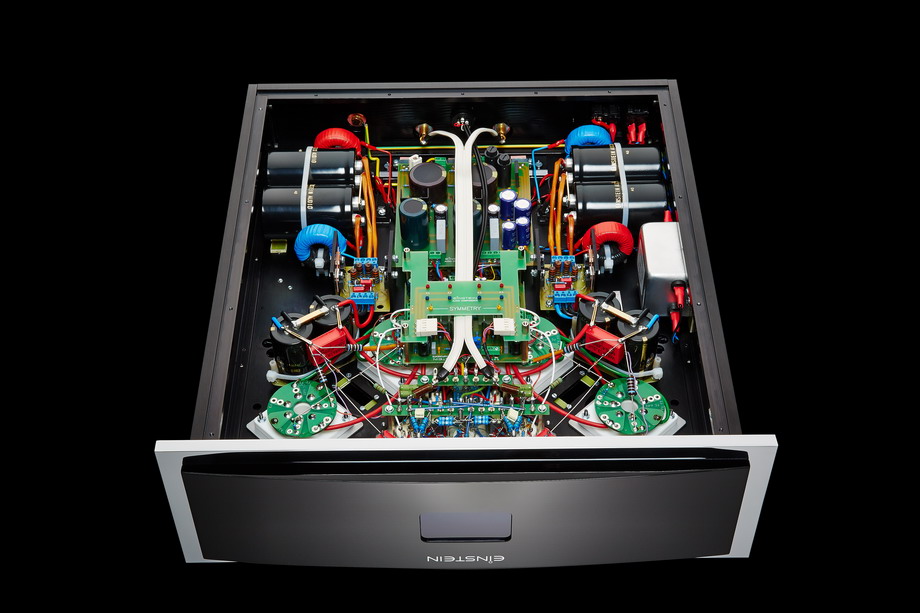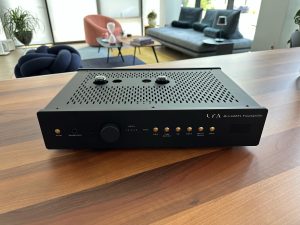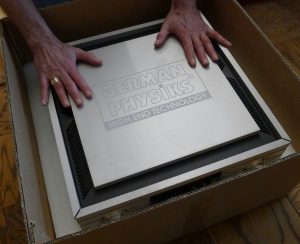While getting ready to conduct another interview for "The Editors" series, I sent an appropriate enquiry to the largest printed German audio magazine—Audio (it is a coincidence, of course, but the latest interview from the series also involved another printed German magazine—"Stereo", read HERE ). Audio has been published for many years and it is part of the same publishing group as, for example, Stereoplay. It is perhaps the most well-known German audio magazine that is still printed.
Bernhard Rietschel, the Editor-in-Chief of Audio, responded to my email very quickly. He liked the idea very much and was really keen on taking part in the project, but:
The only problem is that I am going to leave "Audio" at the end of July. I have been working here as the Editor-in-Chief for twenty years. The thing is that the publisher wants to move the whole magazine to his headquarters in Munich, which is, for many reasons, totally unacceptable—not only for me, but also for the whole "Audio" team.
So, the magazine is still going to be published, but beginning from the 10/2015 issue it is going to be prepared by completely different people.
I do not know if you remember, but my friend's—Dirk Somner's magazine also has its seat in Munich: hifistatement.de. It is where, by the way, my test of the Accuphase A-70 amplifier has just been published in German, read HERE; while Dirk's review of The Preamp can be found HERE). Isn't it a coincidence that the largest high-end exhibition in the world is held in the capital city of Bavaria and that the largest German audio magazines have their seat there? I do not think that there is such a thing as coincidence, as far as I understand probability calculus correctly, but there must be something in the city that attracts people conncected with high-end audio.
Einstein
So, it should not be surprising that the company whose products we are testing this time is also connected with this place. The Einstein brand is Volker Bohlmeier's lifework. I had the opportunity to meet him over dinner during the exhibition in Munich this year (read HERE). I then learnt that Volker is Dirk's good old friend. They met at the university and used to play together in one band—Volker played the guitar and Dirk—the bass guitar. It was when I heard Volker's products for the first time in a controlled environment (i.e. not at an exhibition)—they are the point of reference in the mastering and testing system of the Editor-in-Chief of hifistatement.net, in his studio in Munich.
The company, celebrating its 25th anniversary, owes its name to Albert Einstein, the mathematical genius. His father, Hermann Einstein, ran an electrical company at the end of the 19th century in Munich. He chose to work with direct current at that time, just like another genius—Alexander Graham Bell. And although Bell was wrong, because the "right" current was alternating current, it is he who is known as the "father of electricity"—not Nikola Tesla, who understood the new invention better. Anyway, the use of alternating current in households and for the purpose of lighting streets forced Hermann Einstein to close the company down.
When it comes to Volker's company, it was built on the right foundations at the very beginning, so it has been successful. It is a premium, high-standard company. It can be seen right away when we look at any of its products—they are characterized by a tasteful form, excellent craftsmanship and nicely matched packaging.
The company started in 1990 with a solid-state amplifier called The Amp and, as Michael Fremer writes, the amplifier was a hit for the next six years when it was in production (read HERE). The next step for the company was to manufacture tube products that strengthened its status. Today, the company is known all over the world, especially in Japan, where its product tests and advertisements are regularly published in the most important Japanese audio magazine Stereo Sound.
Both of the tested devices entered production in 2012 and they are, as far as high-end standards are concerned, fairly new products. Non-standard solutions have been used in the construction of both and although they can also be found in products of other companies, here they have been upgraded with exceptional care (read below to find out more about the company history).
The Preamp
The preamplifier is the successor of The Tube model. Its specific feature is a completely balanced design and the presence of as many as 19 amplifying tubes—double low-power triodes: 10 JAN Philips NOS 6922 tubes on the input and 8 EI NOS PCC 88 on the output. The latter used to be applied in deflection coils of TV sets, but also prove very useful in audio devices. 10 input lamps operate all the time (two per channel). Each input has its own complete path, with tubes and other elements.
Normally, there is a selector (switch) on the input, which is used to select the active input. After switching to the source that we want to listen to, signal gets to the appropriate preamplifier where it is buffered, amplified and damped (in different configurations).
The Preamp has been built in a different way. All its inputs are active all the time—there is no input switch. By selecting the input that we want to use, we connect heater voltage to the tubes that operate in it. So, it is necessary to wait for a moment before sound can be heard.
Volker has decided to choose such an expensive and inconvenient solution because tubes are extremely sensitive to what we connect to their control grids (to the input in this case) and loading the input with a switch is problematic. Of course, one can try to get the best selector in the world, but there is nothing better than a lack of it—so, there is no switch in The Preamp signal path—it is located outside it.
The Silver Bullet OTL
The main feature of Volker's monoblocks is included in their name—it is an OTL (Output Transformer-Less) design. In classic tube amplifiers, between the amplifying element, power tubes and the speaker there must be an impedance-matching transformer which matches high tube impedance to low speaker impedance. It means having a few hundred meters of wire, usually of poor quality, in the signal path. However, transformers also have their advantages—among others, the important function of protecting speakers from damage.
So, there are pros and cons of eliminating a transformer from the signal path. However, it is possible if tubes of low output impedance are used in a parallel connection of two or more—the most frequently used ones are the Russian 6C33B tubes, but the EL509 pentodes and other tubes are also used. The most famous companies that have made such tubes their hallmark include Atma-Sphere and GRAAF.
As a rule, an OTL amplifier must have a balanced design, which neutralizes tube supply voltages. Earlier designs often had a problem with that—when one of the lamps (in one of the signal halves) changed its characteristics in time in a different way than other tubes, or—God forbid!—was damaged, the whole supply voltage appeared on speaker terminals, which resulted in their instant destruction.
So, the success of the Einstein company connected with OTL amplifiers relies to the same extent both on excellent sound and exceptional protection circuits. To tell you the truth, I have not heard of anyone having problems with any Einstein amplifier.
A few simple words with…
VOLKER BOHLMEIER
Einstein Audio | CEO
I first met Rolf Weiler, who is responsible for all EINSTEIN designs, in the 1980s. It was in Wiesbaden and we were trying to repair a Braun Coffee machine together around midnight at the home of a musician—our friend. I soon found out that Rolf is also a musician (he plays the saxophone) and has a similar idea of how music should be "reproduced" by an amplifier.
Since he is a professional high frequency specialist and an extremely experienced designer, he had already come up with a precise plan of how I could make this vision come true.
In 1988 we hurried up with our preparations and the EINSTEIN Audio company was registered a year later. It employed three people at that time: Volker Bohlmeier, Rolf Weiler and Gerhard von Berswordt-Wallrabe. In the same year the first prototype of a transistor integrated amplifier—The Amp—was prepared and presented at the Internationale Funkausstellung (IFA) exhibition in Berlin. Its production started in 1990. The amplifier was awarded the Component of the Year award by the Japanese magazine "Stereo Sound" for two consecutive years. It is important to know that it is very rare for a Japanese magazine to award the same product twice in a row.
By the way, I also met my wife in Wiesbaden. She was studying Interior Design at the university. She gained her engineering diploma there and has now been responsible for the look of our products for more than twenty years. She is also responsible for feeding me well (laugh). She really is a great cook, too. My job in this field is to find the right wine for the food she serves. My cellar is big enough, so, up to know, I have always been successful.
All in all, Wiesbaden has not been a bad place for me.
Since then we have produced several EINSTEIN amplifiers, so each of them is closer to our ideal. One of Rolf Weiler's maxims is that ‘The best amplifier would be an amplifying wire'– and it has been the premise for designing any EINSTEIN product. In general, this means that the signal path has to be as short as possible and that signal should stay as unmodified and pure as possible.
I think we have gone very far with both "The Preamp" preamplifier and the "Output TransformerLess" mono power amplifier called ‘The Silver Bullet'. In our opinion, both are milestones in every single respect. Both designs show very clearly Rolf's capability to create unorthodox but elegant and perfect technical solutions, such as the switching of the heater voltage of the input tubes for input selection on The Preamp, which is truly unique.
The EINSTEIN Silver Bullet OTL is another typical EINSTEIN product, offering a fully symmetrical circuit design, which guarantees the best possible signal-to-noise ratio. Even numbered distortions, which have adverse effects on sound quality, are simply not part of this type of a circuit and therefore the signal remains pure and free from any such distortion interference. Each EINSTEIN product offers such simply brilliant features which make the EINSTEIN amplifiers sound so incomparably pure and natural—just as if there was no amplifier at all—and they are definitely part of the success of EINSTEIN.
During all these years we have improved every single circuit many times—and we continue doing research, and are constantly using new parts, new materials and new technologies, exploring new production possibilities to check if they offer an opportunity to make our products even better and to bring them to new levels of refinement. Knowing where we are today, I wonder if we are going to be able to improve some things any further. But when I look at our very new products, I think there is still left a little bit of room for change and improvement. Taking the last steps requires even more effort, but I really believe it`s worth the work. After all the years in the audio business, I am still very happy with my job and I am very keen on going on.
I don`t want to say, "I praise God"—that would be too much, but in some way it was a lucky coincidence for me to end up in this profession. I still really enjoy listening to music when I am not busy trying to improve my guitar performance. As I used to tell my wife, I started dealing with high-end music systems when I realized that I would never be a first-class guitar player. But here, just like in the case of wine, I am quite a good collector.
SOUND
Recordings used in the test (a selection)
- Abraxas, 99, Metal Mind Records/Art Muza JK2011CD07, gold-CD (1999/2011).
- Carmen McRae & Julie London, Carmen McRae & Julie London Bethlehem/Victor Entertainment VICJ-61458, "Bethlehem K2HD Mastering Series | No. 8", K2HD CD (1954/2007).
- Depeche Mode, Ultra, Mute/Sony Music Labels SICP-30543, Blu-spec CD2, (2007/2014).
- Dominic Miller & Neil Stancey, New Dawn, Naim naimcd066, CD (2002).
- Electric Light Orchestra, Discovery, Epic/Sony Music Japan SICP-30112, Blu-spec CD2 (1976/2013).
- John Coltrane, Soultrane, Prestige/Analogue Productions CPRJ 7142 SA, (1956/2014).
- Rogers Waters, Amused To Death, Columbia/Legacy/Analogue Productions 5478842, SACD/CD (1992/2015).
- The Modern Jazz Quartet, European Concert. Volume One + Two, Atlantic/East West Japan, AMCY-1186-7, "Atlantic Jazz Collection, 50 Years", K2HD, 2 x CD (1960/1998).
- This Mortal Coil, HD-CD Box SET: It'll End In Tears, Filigree & Shadow, Blood, Dust & Guitars, 4AD [Japan] TMCBOX1, 4 x HDCD, (2011).
- Thom Yorke, The Eraser, XL/Warner Music Japan WPCB-100001, CD (2006/2007).
- Tomasz Stańko Quartet, Lontano, ECM 1980, CD (2006).
The so-called "neutrality"
One of the idioms of the audio world is the conviction that an audio product should reproduce sound faithfully enough to make it impossible to be distinguished from a live event. It is a beautiful and admirable idea which I have written about many times. However, just like any other idea, it is just a thought construct which cannot be fully implemented. It is not even known exactly what it would be like if this was accomplished—would you have a philharmonic hall at home? A concert hall or a stadium? That would mean the first sounds would ruin the whole room, or perhaps the whole building. The volume would be so high that not only our windows, but also all our neighbours' windows would be blown out. And this is just one of many problems.
Sound reproduction at home is therefore a separate field of knowledge and art. As such, it has both a "core" that everyone agrees on, i.e. there is a general consensus regarding a set of features that everyone accepts as the right ones, and a margin which is also characterized by common agreement, but with modifications that depend on each individual. That is why in perfectionist audio and its assessment there is a tendency to be as objective as possible, and at the same time keep "my own" subjective opinion at a healthy level.
So, when I read a text such as the one below, I just give up, because it either demonstrates a complete lack of understanding of what audio is and what it is not, or—quoting the text below—idiocy:
[… ] It is NOT THE PURPOSE OF A PREAMPLIFIER to inject different colorations into sound to mask out the imperfections of the previously located components. By enabling users to do pick the tubes for different sources and putting those objectives into the initial design is an indication that either the designers were Morons who had no idea what they were doing or the unit was meant to be used by Morons.
Romy the Cat, The objectives of Einstein self-entertaining Preamp, www.goodsoundclub.com , 05.08.2015.
Since there is no such thing as "ideal live-like sound", we can move within some space in which two different kinds of sound can be equally good and can equally well express the intentions of the artist and the team responsible for recording and publishing the material, to the extent that the music reproduced arouses our emotions. These could be any emotions—even boredom and impatience, as live music performances often cause them. It is important that the sound should be of high enough quality to make us sit in front of speakers or with headphones on, waiting for what is going to happen in a moment, completely involved in the experience.
Tubes and their sound
And, to tell you the truth, I hadn't expected that of Volker's amplifiers. Of course, I had been aware that it was a top-class product—it was enough for me to see products with the Einstein company logo in Dirk Somner's system. However, I feel reluctant to use the 6C33B tubes. It is the same feeling as in the case of the KT120 beam tetrodes—they have been accompanied by interesting amplifiers, sometimes very good ones, but it has never been "my" sound, until I heard the I-35 integrated amplifier produced by the Jadis company from France (more HERE). The way in which the company implemented the tetrodes made the sound outstanding (bearing in mind the price of the device).
Einstein
So, what I have been waiting for all these years is, perhaps, The Silver Bullet OTL amplifier—I have been waiting to hear what this tube can really do or to check what can be done with it when one knows what kind of a device it is. The German amplifier, both with my Ayon Audio Spheris III preamplifier and with The Preamp, produced low dense sound, which is what I like. The density did not result from additional bandwith load or from colorations, but from an incredible number of harmonics sounding in unison with the basic sounds. This gave an impression of a multitude of "sounds". I know people who are repelled by this, because they feel "harassed" by such a great amount of information. However, I think that after accommodation they would find out that it is also "their" sound and that afterwards everything else would sound empty and dead.
As I am saying, I have listened to the amplifier both with the reference preamplifier and with its natural partner – The Preamp. I suppose that everything sounds better with the latter. Both systems are representative of a similar class, but the features in question were more prominent and impressive in the Einstein set-up.
This is music which comes TO US, as opposed to music from the Naim Statement system that I once heard (read HERE and HERE). In the case of that system, it was WE who entered the musical message. Although, in my opinion, the systems belong more or less to the same class, our perception of them is completely different. Einstein fills the space in a room as if it was transforming the existing air particles into other ones created by the recording.
It is easiest to hear in the case of tracks in which space plays an important role, e.g. Roger Waters's Amused To Death. The album, which has just been re-issued by Analogue Productions, has been coded in the QSound system, thanks to which sound literally surrounds us. With the Einstein amplifier it was a thick, smooth and tight cocoon.
Contrary to what one might expect, Waters's music is not easy to reproduce correctly, because it is easy to brighten it up, to destroy the very SOMETHING underneath that makes sounds stick together. When it comes to demonstrating surround effects, we can do it in any stereo system. It is completely different in the case of monophonic records—here it is impossible to impress the listener otherwise than through perfection. The Einstein amplifier is capable of doing this—just listen to Julie London from the extra recordings on Carmen McRae's album (released by Bethlehem), or the new remaster of John Coltrane's Soultrain (also from Analogue Productions)—the fulness, volume and, at the same time, naturalness of the musical message were outstanding each time.
Power amplifiers, even the powerful ones, have a problem with fast, dense rock music, as if they cannot deal with distortions (it is also signal) and compression, not to mention high levels of sound. Again, Einstein is a different story. I had had similar listening experiences only twice before—first with the Octave MRE 220 monoblocks, and recently with the Crossfire Evo Ayon Audio monoblocks.
The latter ones were amazing in how well they energized the listening room (i.e. my living room) and how beautifully they went low to produce amazing bass, even in "difficult" songs from Depeche Mode's Ultra album. The amplifiers were brought to my place from Austria by Gerhart Hirt, the owner of Ayon. He asked me for a short listening session to check if everything was all right with the tubes. That "little while" lasted for over an hour and I think that Gerhart enjoyed listening as much as I did. I picked one album after another without too much thinking, because the music was alive, it "talked" to me and made me happy.
However, no matter what I say, the Ayon amplifiers did not play low bass as well as my Soulution 710 and therefore the whole musical message was not that solid and precise. Again—the systems belong to a similar class, but the sound was different in many details.
In this respect, the Einstein system sounded more like powerful transistor amplifiers. I am talking about control and coherence here. It also differentiated sound planes better. Milton's vibraphone from the album recorded during European concerts of The Modern Jazz Quartet was characterized by large volume, incredible sonority and depth, and it was clearly situated at a different place—in every dimension—than the double bass. It is like when we talk to someone and suddenly hear someone talking right next to our interlocutor, but slightly further away and a bit to the side. There is only a small difference, but we instantly KNOW that this is somebody else.
As regards the German amplifier, it was a beautiful story, without putting too much emphasis on anything. It is so, because the message is, as I would put it, soft inside. Not "softened", but "soft" and live-like. The attack is precise, but does not cover what is behind it, i.e. the sustain and decay. The sound is a complete whole.
It was not the first case when I knew that I was listening to an amplifier (an amplifying system) clearly better than my own—earlier I had come across the abovementioned Naim and Ayon amplifiers, and the Ancient Audio Silver Mono SE amplifier that I knew both from my system and from Janusz's system (Krakow Sonic Society). There is also the Kondo Kagura amplifier that I have heard a few times, but not in my system. These are the three model amplifiers for me, although each of them sounds in a different way. My reference system would be next on the list, along with the Phasemation CA-1000 i MA-1000.
Comparison
In combination with The Silver Bullet OTL, The Preamp sounds in its own unique way. The Naim Statement produced more detached sound characterized by higher dynamics. The foreground in it is set much further away and the sound is built "from behind", as if we were sitting in the middle of a philharmonic hall. The tone is less saturated at the bottom of the midrange, but more developed towards the treble—it is more open. The Einstein amplifier sounds more as if we were the only listeners at a concert sitting in the front row, having direct contact with the performer.
The Spheris III and the Ayon Crossfire Evo sound lower, with slight stress on mid bass and low midrange. Their treble is sweeter and situated a bit further away that in the Einstein amplifier. However, the musical message as a whole is shaped in a very similar way: it is a bit warm, dense sound characterized by outstanding tone. It seems that the German system sounds a bit more tangible and that it is more open as regards the treble.
When compared with them, the Japanes Phasemation system consisting of the CA-1000 preamplifier and the MA-1000 monoblocks sounds much more "tube-like", providing that the term means warmth, sweetness and saturation. As regards the Ancient Audio Silver Mono SE, it is much more open, faster, more dynamic and produces lower bass—only the Naim Statement sounded lower in my system, with more authority.
Limitations
Of course, there are also limitations, because they are an inherent part of life. Volker's amplifiers should work well with high-impedance speakers and it would be best if their impedance was higher than average. Otherwise we will overload the amplifiers and they will turn off, which is, by the way, great news—it means that protection circuits work well. Anyway, overloading will occur with completely different records and sources than we expect.
As far as I am concerned, Volker's amplifiers with Harbeth M40.1 speakers in a medium-sized room (ca. 30 m2) and close to the place where I was listening, had no problems with Waters, Depeche Mode and Deep Purple albums, but one of the channels switched off halfway through Dominic Miller and Neil Stancey album New Dawn (to be more precise, while I was listening to the song entitled Rush Hour). I remember the song from a concert in Bielsko Biała, which I attended and sat in the front row, so I wanted to turn the volume up to feel as if I were in the audience again. These are just two acoustic guitars, but the three LEDs turned on. After a while the amplifier turned on again, but I had to turn the volume down a little, to prevent the situation from happening again.
I admit that it was very loud and the situation did not occur again when we listened to the amplifier "normally". It shows, though, that it is necessary to be careful with the surroundings in which the Einstein amplifier works. No such problem occurs in the case of other abovementioned amplifiers—the Naim and Soulution amplifiers play music as loud as we want and there are no distortions, while the tube amplifiers that I have written about will simply overdrive sound—it will not be that good anymore, but it will still be suitable for listening.
I do not see any other problems, if such sound aesthetics and look suit us. Heat emitted by the system may perhaps be problematic—the amplifier is quite a large heater. I listened to it during the hottest week of the summer holidays and I could hardly bear the heat in the room. It would be better in winter, but it is necessary to know that here we are talking about an enormous amount of heat, anyway. This is the nature of tube amplifiers and the 6C33B tubes in particular.
Summary
The Einstein system belongs to the elite of devices that are outstanding in every respect. The combination of saturation with differentiation, consideration with entertainment, precision with fluidity and detail with the totality has resulted in something brilliant—wonderful sound! The quality of workmanship is perfect. It is an amplifier which meets both pro system requirements, i.e. those that require selectivity, resolution and precision, as well as tasteful "vintage" systems requirements, focusing on tone and the "flow" of energy.
A few simple words with…
DIRK SOMMER
hifistatement.net, Sommelier Du Son
Einstein, Volker and me…
When I had read my dear colleague Wojtek's article about my wife's (Birgit) and my visit to Cracow and our meeting with the Krakow Sonic Society, as well as the first part of his show report of this year's High End exhibition in Munich, I thought that the editor of "High Fidelity" seems to be a real investigative journalist. Apart from musical and technical stuff, he has freely written about the relationship between Birgit and me, and added some anecdotes I told him about the times when Volker Bohlmeier, the managing director of Einstein Audio, and I played R&B together in my small student flat. Volker used a Marshall top with a 4x12"cabinet for the electric guitar and I used the Marshall Super Bass 100 with a 4x15" cabinet for the electric bass. Sometimes we were accompanied by a singer and a second guitar player.
After Wojtek published even more details about the old times—if I remember well, he mentioned a glass of wine now and then—it didn't make sense for me to deny it anymore in the light of such clear evidence. So, I confirm that Volker and I have been friends for more than 30 years. When Wojtek asked me to write a few lines about the Einstein pre and power amp that I have in my set-up, I thought it might not be the best idea to write about components manufactured by a company of a friend. On the other hand, I didn't want to turn down a colleague's request, so here we are. I shouldn't care whether you read my remarks as ones made by a reviewer or a friend.
At the time when Wojtek and his son Bartek visited me in Munich, I had just finished a review of the AudioMachina's Maestro GSE speakers that were bi-amped by two Einstein Audio The Poweramp power amplifiers. Usually there are the LumenWhite DiamondLight speakers driven by the Ayon's Epsilon monoblocks with the KT 150 tubes playing in my listening room, aka my office. If it is not needed for a review, one of The Poweramps is used in Birgit's set-up in the living room. There she decides what components sound and look best for her.
I'm only asked for advice now and then—but I have been able to convince her to listen to a pair of the Acapella's Violon VI speakers for some time. And these speakers are not easy to drive, but not because of low impedance or other surprises that shock the amplifier. Most amps Birgit and I have tried with the Violon didn't produce coherent sound from its plasma-tweeter, the midrange horn and the conventional woofer.
Hermann Winters, the owner of Acapella, recommended the Einstein Silver Bullet OTL for his speakers, but we tried the much more affordable The Poweramp and, all of a sudden, the Violon speakers produced consistent sound. I do not have an explanation for this effect, but it's easy to hear: Acapella and Einstein are a top match. Of course, The Poweramp is great in all other respects like the dynamics, details, soundstage, fluency and tonality, but it is the fact that it forces the Acapella Violon to play absolutely coherently that makes it so outstanding to Birgit and me.
When Volker brought me the AudioMachine speakers and one additional The Poweramp for bi-amping, he also had The Preamp in his luggage and asked me if I would like to hear it. Of course I did!
Before we changed anything else in my system, we heard my standard set-up with The Preamp instead of the EAR 912, which I liked for its dynamic, powerful and meaty sound—and for its technical studio appearance. Visually, the shiny Einstein Preamp is the total opposite. What is more, the unique and technically convincing way of switching the inputs, because of which changing the active input takes some time, is the last thing a reviewer who wants to make quick A to B comparisons would happy about.
However, it all didn't matter. After I've listened to the first song, it was clear that The Preamp should stay in my set-up. And it has stayed there until today: The Preamp has produced a much broader and deeper soundstage than the EAR, played a little more dynamically and integrated some more details perfectly in the flow of the music. I can't remember having heard a better-sounding preamp in my listening room.
DESIGN
Both devices are wonderfully constructed and they also look fantastic. As Volker told me, his wife is responsible for their artistic design. She specializes in interior design and she has done a great job here.
The housing of both devices consists of thick aluminum boards, with a chromium-plated front with a black acrylic element. A little slot has been left in the centre where three blue LEDs are located. The central diode normally turns on when the amplifier is working, while all three diodes turn on when the amplifier turns off for some reason or turns off outputs—e.g. after unplugging speaker cables. The devices stand on tall aluminium feet.
The power cable is connected to the preamplifier from the bottom and we have to use an angled IEC connector for the purpose. So, it may be necessary to use Einstein power cables here, which I did during this test.
The Preamp
There are as many as 18 tubes in the preamplifier—ten on the inputs (two JAN Philips NOS 6922 tubes per input) in the amplification section and eight EI NOS PCC 88 tubes in the other, buffering section. The former ones are mounted on boards decoupled from the housing with the use of springs. There are five inputs—three unbalanced RCA inputs and three balanced XRL inputs. There are also two outputs: RCA and XLR. The Preamp is balanced, so it is worth using the XLR path. Since there are different tubes in each of the inputs, one can have some fun and place different tube types in them.
Chromium-plated covers of power supply transformers can be seen in front of the tubes—it is a dual-mono device. The electronic circuit has been assembled using a time-consuming and thus expensive point-to-point method, which guarantees the best sound effects. In the circuit there are many components that are part of the amplifier (stabilized voltage for each section) and polypropylene Suntan capacitors used here to couple large electrolytic capacitors.
The preamplifier is controlled using a remote control, which looks different than any other remote control. It has an aluminium housing with a rounded upper part and four rubber "feet" at the bottom. However, in this case all buttons are located at the bottom. So, we place the remote control upside down, like a telephone receiver. It looks great, but the buttons are tiny and have the same shape and size. The remote control is used to control the preamplifier and CD player with Philipsa CR5 codes, such as in the CD-Pro2 transport.
The Silver Bullet OTL
As Volker says, only 15% of ordered 6C33B tubes can actually be used, and just some of these can be connected into a well-matched quartet. The rest goes into the bin. Tubes are preliminarily heated and those that survive are measured. The ones that undergo the whole process can then work for many years without any problems—they are more stable than the whole range of KT and EL tubes.
The six input lamps are the same double EI NOS PCC 88 triodes that are used in the preamplifier. They operate in the input buffer and in the control circuit. In the output section there are four high power 6C33B triodes per channel in a symmetrical arrangement, without output transformers. So, this is a thriode amplifier from input to output. Hollow metal elements can be seen between the thriodes—they are used to cool the inside and the semiconductor elements that are fixed to them. It is important because there are quite a lot of such elements here—their function is to monitor voltage and to protect the amplifier.
Power supply circuits in the device are placed on printed circuit boards, while amplifying circuits are mounted using the point-to-point method. There are two transformers in each monoblock, separate for the negative and the positive half of the signal. Each transformer works with large Einstein capacitors and chokes—their coils are wound around toroidal cores. There are also thick gold-plated bus bar connections for high currents. Each stage is coupled in Wima capacitors.
Technical specifications (according to the manufacturer)
The Preamp
- Signal to noise ratio: typ. 100 dB
- Distortion: < 0.01%/1 kHz
- Output voltage (XLR): 2.5 V/100 Ω
- Maximum input voltage: 7 V
- Output impedance: 50 Ω
- Bandwidth: 7 Hz—400 kHz
- Channel separation: > 98 dB
- Dimensions (H x L x D): 200 x 430 x 410 mm
- Weight: 21 kg
- The Silver Bullet OTL
- Signal to noise ratio: >98 dB
- Distortion : < 0.02%/1 kHz
- Output power: 80 W/12 Ω, 65 W/8 Ω, 45 W/4 Ω
- Damping factor: >95/8 Ω
- Dimensions (H x W x D): 240x 430x 490 mm
- Weight: 30 kg/Mono Amplifier
Price (at the time of the test):
The Preamp—€17,000
The Silver Bullet OTL—€40,000/pair
EINSTEIN AUDIO COMPONENTS GmbH
Prinz Regent Straße 50-60
D-44795 Bochum | Germany
MADE IN GERMANY
Text: Wojciech Pacuła
Photos: Wojciech Pacuła | Einstein
Translation: Ewa Muszczynko




